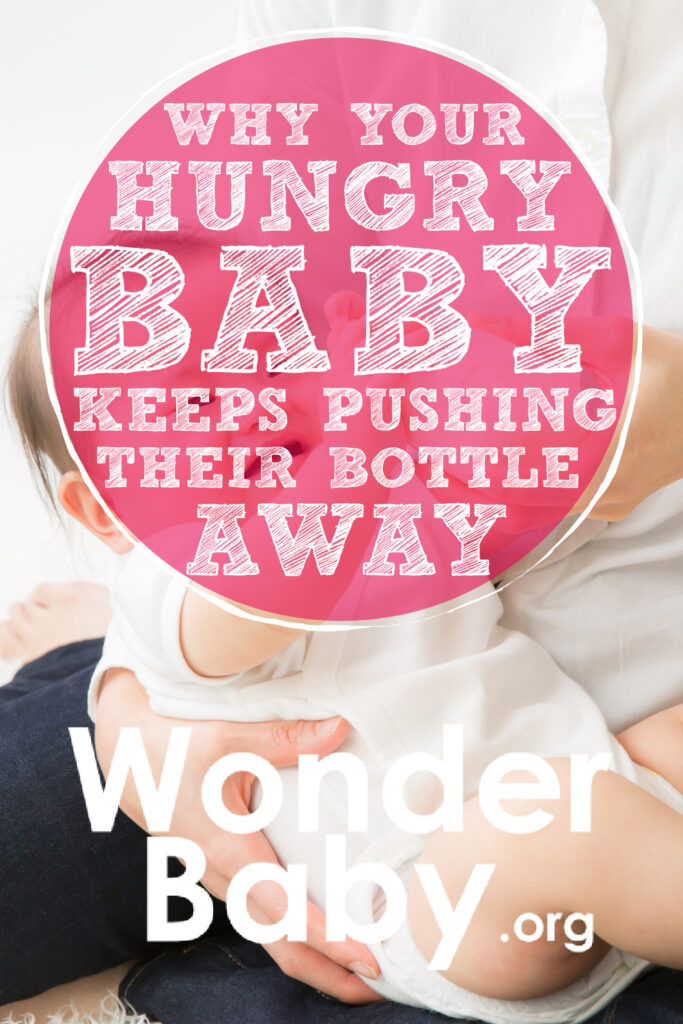Why Your Hungry Baby Keeps Pushing Their Bottle Away

- Many babies go through a stage of stopping feeds when they’re still hungry.
- Possible causes include distractibility, teething pain, and trapped gas.
- A couple of underlying health conditions can put your baby off feeding, such as reflux, so it’s worth speaking to your pediatrician for advice.
- It’s important to stay calm so your baby can’t pick up on any anxieties you may have about their feeding patterns.
No matter how you feed your baby, those feeds are probably one of the highlights of your day. It’s lovely to have some one-on-one time to snuggle your baby close, gaze into their gorgeous eyes, and watch them drink their formula or breast milk. It’s not always easygoing, however; sometimes feeding can become a source of anxiety.
A lot of parents feel anxious about their baby’s eating habits. Whether they’re eating too much or too little or feeding at the right times of day, it doesn’t matter whether your baby is bottle feeding or breastfeeding—feeding time can be stressful. As parents, there’s an endless stream of things to worry about, and making sure your baby feeds often enough to thrive is a big one.
If your baby pushes their bottle away but is still hungry, you may be worried they won’t get enough milk. Whether you’re formula feeding or bottle feeding a breastfed baby, a baby pushing their bottle away is a common frustration. Bottle feeding problems are a common cause of anxiety for new parents, so please know you’re not alone here.
How can you encourage your baby to finish their bottle? And does it matter if they drink all their milk at each feed? Remember, your baby is constantly growing and developing, so their patterns will change.
Reasons Why Babies Might Push the Bottle Away

There are lots of reasons why your baby might push the bottle away. Sometimes, they may push the bottle away because they’re done feeding. Remember, sometimes babies can be hungrier than usual, and other times, they may need to eat less. For example, babies may not eat as much when they’re under the weather.
A baby pushing a bottle away can signify lots of different things, such as:
Physical discomfort
Sometimes physical discomfort can make baby push their bottle away. It could be due to pain from an illness like an ear infection, or just normal pain from gas or teething.
Gas or bloating
Some babies take in lots of air during feeds and may need burping before they can finish their feed. Having trapped gas can be quite uncomfortable for babies, so your baby may get upset if this is the cause. Try holding your baby in an upright position and gently patting them on the back to see if they bring up any trapped air. After burping your baby, they’ll likely be happy to continue their feed.
If bottle refusal is a repeated problem, you might need to resize the bottle’s nipples. If the nipples are too large, the fast flow could be causing your baby to swallow air between gulps. On the other hand, if the bottle’s nipple is too small, your baby may have to swallow hard and may be swallowing air unintentionally at the same time.
Teething pain
Your baby’s gums may be sore if they’re teething. Teething pains can start months before they get teeth, so your baby may suffer from teething discomfort long before you were expecting it. Many parents are surprised when their babies show signs of teething pains as early as ten weeks old. Your baby pushing the bottle away could be a sign that feeding is causing discomfort.
As you can probably imagine, swollen gums can feel sensitive and can make feeding tricky. Cold teething toys can be used to provide relief before feeds, and this may help your baby to feed with less discomfort. Your baby may also get relief from gumming down on toys, so ensure they have access to teething toys
Emotional or sensory factors
It’s not always physical discomfort that’s to blame—emotional and sensory factors may also be causing bottled feeding problems. Potential causes could include:
Overstimulation
Babies can easily become overstimulated by their environment. Your baby may be too distracted to feed when there are bright lights, loud noises, and a buzz of activity. If you think overstimulation could be causing your baby’s bottle refusal, try feeding in a calm environment.
Some babies prefer to feed in a calm environment, especially when they reach an age of becoming easily distracted. Choose someplace away from the hustle and bustle, dim the lights, and reduce noise to allow your baby to relax.
Need for a break
Sometimes, babies just need a break, and that’s fine. Calmly accept your baby’s need for a pause, and try offering the bottle again after a short break. Just as breastfeeding moms offer the breast often, you can do the same when you’re bottle feeding if you’re worried your baby isn’t finishing their bottles.
Try not to worry too much about how much your baby takes per feed and instead focus on how much they are taking over a 24-hour period. You may notice your baby has hungry times where they take more milk and quieter periods where they don’t feed so much. As long as they’re still taking enough milk and producing wet and dirty diapers, it’s likely nothing to worry about.
Feeding technique issues
Sometimes, it could be something simple like the feeding technique causing the problems. Try troubleshooting the following to see if they could be causing issues:
Improper bottle angle
You should hold your baby’s bottle at a 45-degree angle to allow for proper milk flow. The bottle’s nipple should be full of milk to ensure your baby isn’t gulping down air with their feed. Baby pushing their bottle away is a reminder for you to check your positioning and ensure your baby is in an optimal feeding position.
Bottle nipple confusion
Babies appreciate consistency; switching the bottle nipples too often may confuse your baby. Try to stick to nipples of the same flow rate or shape, so your baby knows what to expect.
If you’re breastfeeding, it’s important to choose bottles for breastfed babies with nipples that mimic the shape of a mother’s breast. Even if your breastfed baby has breast milk from a bottle, it’s worth choosing bottles designed to be breastfeeding-friendly to make feeds easier.
Health concerns
Sometimes, your baby’s health may be causing the issues. There are a couple of health complaints that could interfere with feeding, including:
Thrush or oral yeast infection
Oral thrush can be painful for little ones, especially during feeds. Symptoms of oral thrush include white patches inside your baby’s mouth and fussiness during feeds. Some babies also get persistent diaper rash when suffering from thrush. Your baby will need medicine to treat the condition, so make an appointment to see the pediatrician as soon as possible.
Reflux or GERD
A baby is born with an underdeveloped esophagus, which can allow milk to come back up easily. Most babies grow out of this condition as their esophagus develops with age.
Symptoms of reflux or GERD include bringing up milk during or shortly after feeding, coughing or hiccuping during feeds, fussiness during feeds, and swallowing or gulping after burping or feeding. Your baby may arch their back with discomfort during feeds.
You can purchase bottles designed to help with symptoms of reflux, so it’s worth trying these. If your baby shows signs of reflux, you should ask their pediatrician for advice.
Understanding Baby’s Feeding Cues

Remember, babies change all of the time. Your baby may be hungrier than usual during growth spurts and may eat less frequently if they’re just coming out of a growth spurt.
Rather than expecting your child to stick to a schedule, you may find it easier to follow their cues. If you see signs that your baby isn’t hungry anymore, you may worry less about bottle refusal. As long as your baby is putting on weight and producing enough wet and dirty diapers each day, they’re likely doing okay.
Babies are fantastic communicators, though it often takes us parents a while to understand what they’re trying to tell us. Paying close attention to your baby’s cues could help you recognize signs of hunger and satiation in breastfed babies and formula-fed babies.
Signs of hunger
- Rooting from side to side
- Sucking on fists, fingers, or toys
- Smacking lips or sticking out tongue
- Restlessness or increased movement
Signs of fullness or satiety
- Slowing down or pausing during feeding
- Turning away from the bottle or breast
- Closing the mouth or clamping down
- Relaxed hands and limbs
- Showing interest in surroundings instead of feeding
What To Do When Your Baby Pushes the Bottle Away

If you feel yourself becoming anxious whenever your baby refuses the bottle, it may help to have a set routine of how to react in the moment. This may help you stay calm and feel in control while helping troubleshoot any potential issues affecting your baby at feeding time.
Steps to take in the moment
1. Stay calm.
The biggest gift you can give your baby is a calm nervous system. Rather than reacting anxiously or with stress, focus on staying calm on the outside. Take a deep breath and remind yourself that this is not an emergency. Your baby will know if you appear stressed or anxious and will likely mirror your mood. Stay calm to show your baby it’s no big deal (even though you totally think it is).
2. Check the basics.
Sometimes, there are easy fixes stopping your baby from finishing their formula bottles, so start with the basics. Check your baby’s diaper is dry and they’re not too cold or too hot. Sometimes discomfort can put a baby off their food.
It’s also worth checking the milk and bottle, too. Drip a bit of milk on your arm to check that the temperature is as expected. If the temperature isn’t right, your baby may refuse the milk. Are you using the same formula? Sometimes, a change in formula can trigger a baby to push their bottle away even thought they’re hungry. It’s also worth checking that the milk is flowing as expected.
3. Switch positions.
Sometimes, a change of position may encourage your baby to finish their milk. Perhaps they are uncomfortable or aren’t in a great position for feeding. Try a different position and offer your baby the bottle again. Different positions work for different babies, so keep trying new ones until you find one your baby is happy with.
Long-term strategies
In the longer term, there are some things that may help you and your baby:
Establish a routine
Children thrive from routine. If your baby’s feeding times are routine, they will know what to expect. Try to schedule feeds for a similar time each day. Make a point of seeking out some quiet place to feed your baby.
Seek support
Parenthood is filled with unknowns. Sometimes, it helps to surround yourself with people who know what you’re going through.
Connect with parents at a similar stage so you can lean on each other for support and advice when necessary. Pop along to a local baby group to find other parents of babies of a similar age to yours. Sometimes, just hearing that somebody else is going through the same thing can make it more bearable.
Consult with a pediatrician
If you’re anxious about your baby’s feeding habits, make an appointment to visit the pediatrician. They’ll be able to check for any underlying issues and hopefully convince you that everything is OK. As a parent, it can sometimes be hard to figure out what’s normal and what could indicate a problem. It’s always worth speaking to an expert for advice in these instances.

Related Posts

Feeding and Eating, Special Needs
Feeding Therapy Approaches for Infants with Special Needs
Many children with special needs have feeding difficulties. Working with a speech therapist, being patient, and experimenting with textures can help.

Feeding and Eating
Unexpected Foods That Cause Allergen Cross-Reactivity
A variety of unexpected foods and environmental substances can trigger an allergic reaction through cross-reactivity to food proteins.

Feeding and Eating
Easing Anxiety for Families Facing Food Allergies
Ongoing physical preparations and speaking openly about anxiety can ease the transition from diagnosis to living well with a food allergy.